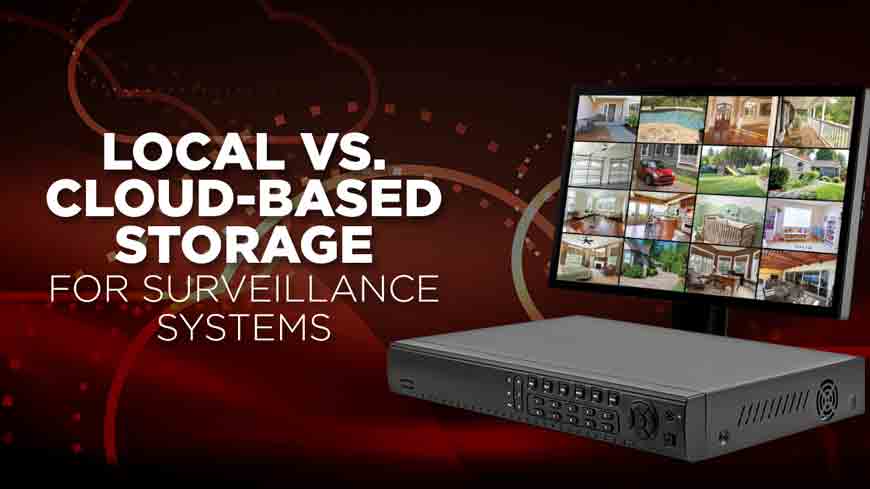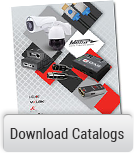
Local Storage Versus Cloud-Based Storage for Surveillance Systems
Tuesday, July 28, 2020 11:07:00 AM America/New_York

When planning a new surveillance system design, knowing the advantages and disadvantages of cloud storage versus local storage surveillance systems is crucial. In this article, the Metra Home tech team goes over the differences and considerations for both. Knowing which to use is the first step in a surveillance system design as it dictates the equipment required for the project. This article will help you educate you and your client on the advantages and disadvantages of both cloud-based storage and local storage surveillance systems.
Cloud-Based Surveillance System Storage
The popularity of DIY doorbell or home camera surveillance systems has made cloud storage a common solution for storing video. Video is recorded and uploaded to a virtual server where users pay a monthly subscription fee to store and view the video feed. The initial camera investment is usually much less expensive but users will pay for video storage or added features. Pricing varies depending on the total number of cameras, but this option can get pricey over the long run and comes with limitations that should be considered.
Local Storage for Surveillance Systems
Storing surveillance video onto a DVR or NVR that is physically located inside the home or business has many advantages. While it does require an initial investment in the equipment and labor to install and set up, it can be much more cost-effective in the long run when storing large video files from high-resolution cameras and/or multiple cameras. Overall, it provides a more reliable and secure surveillance solution than its cloud-based counterpart.
Spyclops Surveillance Systems uses local storage with options for installers to use pre-installed hard drives or purchase a DVR or NVR without a hard drive, which allows the installer to upsell and customize a solution based on their client’s specific system requirements. This option provides a more profitable option for custom integrators than the one-size-fits-all cloud-based solutions.
Advantages and Disadvantages of Each Solution
This information is meant to help custom integrators and home technology professionals present the best home or business security plan to their clients. Below are factors affecting both local and cloud-based storage solutions that should be considered for any new project.
WiFi Internet Speed and Video Resolution
When planning your system design, one of the most important considerations is the internet bandwidth speed of the property, as slow internet connection can hinder the ability to watch video in real-time and show a delay in what the user is seeing. Slower WiFi speeds may also reduce the total number of channels/camera feeds that can be recorded at once. If your client needs several different cameras to cover their property, this could require a significant amount of bandwidth to work properly. Some popular systems will automatically reduce the video resolution if WiFi is limited, producing a video that may be grainy or not show as much detail needed in the event that there is an incident your client needs to review. The takeaway? Slow internet and/or WiFi results in less stable video recording and playback. Hard-wired cameras with local DVR/NVR storage are preferred for reliability if WiFi speed is an issue.
Many local storage solutions are hard-wired, many using Power Over Ethernet, which means WiFi is not needed to record and store video. This makes it an ideal option for surveillance systems being used in new construction, where WiFi is not yet available. It’s also the best option when WiFi isn’t 100% stable or when multiple camera feeds require bandwidth beyond what the property’s internet and/or WiFi can handle.
Full-Time Recording Versus Event Only Recording
Another limitation of many popular cloud-based video surveillance systems is the ability to record full-time, many only record certain events based on motion sensors. This can be an issue if something occurs that does not trigger motion, or if the camera stops recording. Some popular surveillance camera systems only record the first 12 seconds of an event triggered by motion and require a monthly cost per camera for a longer recording window of an event. If your client’s business or home requires full-time recording or the ability to record an entire event once triggered by motion, this is something to consider in your system planning. Spyclops DVRs and NVRs allow the installer to set either full-time or event only recording with the ability to detect motion and once triggered. Many local-based surveillance solutions offer the ability to record all or specific time periods after an event is triggered, and are not limited by settings from a 3rd party cloud-service provider.
Security Concerns
Getting hacked is more likely to occur in a cloud-based system since video footage is stored on a third-party server with everyone’ else’s video footage. Popular systems are often targeted by hackers and if the owner has used a weak password, security can easily be compromised. Using a strong password is a best practice that will help keep video footage secure but it may not be enough. Compared to local storage which is stored on a single network, security concerns for cloud-based storage are more likely to occur and should be considered. Hacking into a single network is an unlikely event unless this client is specifically targeted.
One security concern for local-based storage that you don’t have with cloud-based systems is that if an intruder gets into the property and physically removes the DVR or NVR, the footage will be gone. Properly securing the area where the DVR or NVR is kept may help safeguard against this.
Video Ownership
There is an ongoing debate about legal and privacy concerns regarding who actually owns the rights to video footage stored on a third-party cloud. Cloud-based systems have been the target of subpoenas for police investigations and unlike local storage, the third party that owns and manages the cloud server is responsible for providing that video footage to the authorities in the event that it is required for an investigation. If privacy is a concern for the client, this is an important detail to discuss during your planning stage.
The Takeaway
With the rise in popularity of cheap DIY surveillance cameras with cloud-based storage, installers can differentiate themselves, add value and increase the profitability of their services by explaining the advantages of professional installation and using a local storage based solution. Additionally, a well-educated client with higher security needs could be better suited for upselling a hybrid between local and cloud solutions.
If you have additional questions about your security surveillance system project, speak with the Metra Home tech team for help with network planning and pre-sale technical questions at (386) 255-0234. Videos on these topics are also available for installers on the Metra Home YouTube channel and the entire Spyclops Surveillance Systems product line is available at https://metrahometheater.com/security-surveillance.html.











